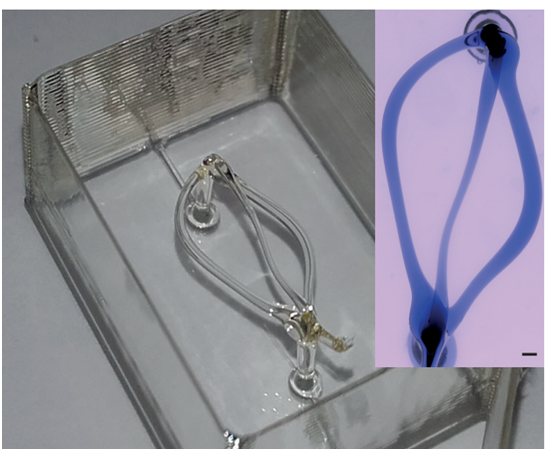![[Source: Eindhoven University of Technology ]](https://fabbaloo.com/wp-content/uploads/2020/05/Glass4_img_5eb094bd169b4.png)
Charles Goulding and Andressa Bonafe of R&D Tax Savers discuss innovations in 3D printing with glass.
The rapid expansion of 3D printing materials has enabled previously unimaginable applications. Recent developments combine additive manufacturing capabilities with the strength, transparency, and chemical stability of glass. Major technical advancements now open the way for innovative uses in design and architecture, photonics, and biomedical devices.
MIT’s G3DP2
![[Source: Tech Crunch ]](https://fabbaloo.com/wp-content/uploads/2020/05/Glass_img_5eb094bd773b5.png)
Researchers at MIT developed an additive manufacturing platform for architectural-scale 3D printed glass. The ground-breaking system combines a digitally integrated three-zone thermal control system with four-axis motion control. It allows for industrial-scale production with increased rate and reliability while ensuring product accuracy and repeatability at unprecedented levels. Capable of producing clear glass structures, the system opens the way for an array of architectural and decorative applications.
Art and Architecture
![[Source: Mediated Matter Group ]](https://fabbaloo.com/wp-content/uploads/2020/05/Glass2_img_5eb094bdd3b2a.png)
As glass 3D printing capabilities expand, innovative applications in art, design, and architecture emerge. Aiming to promote biodiversity, Neri Oxman and the Mediated Matter Group at MIT created a series of 3D printed glass columns infused with liquid melanin.
Photonics
![[Source: Tech Briefs ]](https://fabbaloo.com/wp-content/uploads/2020/05/Glass3_img_5eb094be469cc.png)
Researchers at the Université Laval in Canada have pioneered the use of chalcogenide glass in additive manufacturing. This technical breakthrough required a significant increase in the maximum extruding temperature of the 3D printer, due to chalcogenide glass’ unique transition temperature. The material demonstrates optical transparency in mid-infrared range and could allow for the production of components and optical fibers for low-cost sensors, telecommunications equipment, and biomedical devices. By enabling complex designs and geometries that were previously unattainable with conventional methods, 3D printing paves the way for a new era in the production of photonic components and fibers.
Microvascular Structures
A group of researchers at the Eindhoven University of Technology in the Netherlands have used 3D printing to mimic complex microvascular structures. Among other materials, the team has been experimenting with self-supporting carbohydrate glass, which has shown great promise for the creation of minuscule diameters and intricate network architectures. Even though thermal control remains a challenge, the combination of carbohydrate glass and additive manufacturing could allow for significant advancements in microfabrication of biomedical devices.
The Research & Development Tax Credit
Enacted in 1981, the now permanent Federal Research and Development (R&D) Tax Credit allows a credit that typically ranges from 4%-7% of eligible spending for new and improved products and processes. Qualified research must meet the following four criteria:
-
Must be technological in nature
-
Must be a component of the taxpayer’s business
-
Must represent R&D in the experimental sense and generally includes all such costs related to the development or improvement of a product or process
-
Must eliminate uncertainty through a process of experimentation that considers one or more alternatives
Eligible costs include US employee wages, cost of supplies consumed in the R&D process, cost of pre-production testing, US contract research expenses, and certain costs associated with developing a patent.
On December 18, 2015, President Obama signed the PATH Act, making the R&D Tax Credit permanent. Since 2016, the R&D credit has been used to offset Alternative Minimum Tax (AMT) for companies with revenue below $50MM and, startup businesses can obtain up to $250,000 per year in payroll tax cash rebates.
Conclusion
Enhanced thermal and motion control have allowed for the creation of increasingly diverse 3D printed glass structures. Consequently, applications are found in a growing number of industries, from architecture to biomedicine. Companies engaged in such innovative uses of additive manufacture should take advantage of R&D tax credits.











Researchers are now able to procure incredibly powerful 3D printing equipment at lower costs to enable work that was previously impossible.